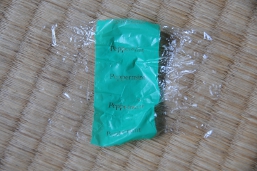 I went to see Katsura Imperial Villa today, I will write a detailed post once I have sorted through all my photos… It is quite far from my house, it took me about one hour to get there, taking two buses. The first one got quite crowded and at some bus stop, I offered my seat to an elderly lady. She was not really ancient, but still obviously happy to be able to sit down. Then, she started rummaging in her bag and after a while she touched my hand – and offered me a mint bonbon… She did not eat any, so I guess it was her way of saying “Thanks”. What a nice thing to do!
I went to see Katsura Imperial Villa today, I will write a detailed post once I have sorted through all my photos… It is quite far from my house, it took me about one hour to get there, taking two buses. The first one got quite crowded and at some bus stop, I offered my seat to an elderly lady. She was not really ancient, but still obviously happy to be able to sit down. Then, she started rummaging in her bag and after a while she touched my hand – and offered me a mint bonbon… She did not eat any, so I guess it was her way of saying “Thanks”. What a nice thing to do!
Bureaucracy
In Asia, many large, legally binding transactions, whether business (buying a house or car) or private (getting married) still require the involved parties to use personal seals rather than signatures. Many people use different seals for different purposes, the more important the business, the more important the seal. The transactions mentioned above require a personal seal that is registered with the local ward the person lives in, and is thus of the highest level. These seals – in Japan they are generally called inkan or hanko – are often elaborately carved, unique pieces that can be very expensive and usually accompany a person throughout their (adult) life.
For practical reasons, and in view of a few important things coming up, I have decided to get my own registered seal or jitsuin, and, armed with my own elaborate design based on my last name, I went to a hanko-ya, a seal-carving shop last week. I must have chosen the most uninspired seal makers of town, because there my problems started…
First of all, they could not tell me whether my design would be acceptable by law. This makes sense, as for foreigners, there are strict rules a jitsuin has to adhere to, and apparently, they even differ from one town to the next. So, I went to city hall (which, thankfully, was not far from the shop) and I spent about one hour discussing with a very friendly young staff member which type of seal would be permissible for me. It seems that in Kyoto (and she stressed that emphatically), I can have a seal containing my last name, my first name, or both in either romaji, roman alphabet, or in katakana. I am not allowed an abbreviation of (parts of) the name, for example initials only, and: The thing must be recognisable as my name! This surprised me quite a bit, because I know that these seals for Japanese often contain very old-fashioned kanji that the modern Japanese probably would not recognise. Also, whenever such a seal is used, it must be accompanied with proof of its registration anyway – which you only get with proper identification…
In any case, she was not swayed, so my beautiful self-designed idea based on my last name with lots of flourishes and hidden letters (although all of them were there, I swear!) was out. So, I asked about katakana on my seal and made a quick, improvised sketch of something. After going back to check with somebody in the know, she returned and said: “Yes, this is possible, and it’s very nice, but you first have to register a heikimei.” Excuse me, a what? We could not quite find common ground on this one. Only at home, when checking the kanji she wrote down for me (併記名) it turned out that it literally means “also shown name”, the Japanese translate it as “pronunciation name”, essentially a way of writing your (foreign) name in katakana. So, in order to be allowed to use a seal with katakana, I first have to register those katakana as equivalent with my name. While it sounds a bit odd, it does make sense from a legal point of view. I guess. In any case, after we both had confirmed that I can register both the heikimei and the seal at the same ward office on the same day, I thanked her profusely and went back to the hanko-ya.
There, my problems went from bad to worse. Now they informed me that there was no way they could possibly furnish me with a seal carved in romaji, as this is nothing they are capable of. Then I said, okay, good, here is an easy design of my first name in katakana, with the syllables nicely flowing together. Oh, no, this was not something they could possibly do either, after all there is a machine doing the carving and the machine cannot possibly be told to move that one kana a bit to the left and the other a bit to the right and besides and anyway…
As I did not know any other hanko-ya to go to, I relented, and they took three days to tell that ominous machine in their backyard to carve the most uninspired and most ugly seal they ever made. I showed it to my friends for commiseration, but interestingly they found it cute – they had never seen a katakana seal before. Well, I thought, as long as it does the trick for registration…
 This afternoon, I went to my ward office to register my heikimei and the seal, and to get a seal certificate as proof that the seal is really my official seal. I braced myself for severe difficulties again, but everything went smoothly. An assistant who is only there to assist people – Japanese and foreign alike – to fill out forms and put them on the right chair, filled out all the forms I needed. For the seal registration, I had to put the seal on the registration form and on a small extra slip of paper – the clerk explained that I should make an extra effort there because this imprint would be scanned and thus entered into the database. After maybe 15 minutes time in total and after paying 350 YEN, I received a registration confirmation and the registration card pictured above. If ever I need a new proof of registration, I’ll only need to show this card and a new document will be issued promptly.
This afternoon, I went to my ward office to register my heikimei and the seal, and to get a seal certificate as proof that the seal is really my official seal. I braced myself for severe difficulties again, but everything went smoothly. An assistant who is only there to assist people – Japanese and foreign alike – to fill out forms and put them on the right chair, filled out all the forms I needed. For the seal registration, I had to put the seal on the registration form and on a small extra slip of paper – the clerk explained that I should make an extra effort there because this imprint would be scanned and thus entered into the database. After maybe 15 minutes time in total and after paying 350 YEN, I received a registration confirmation and the registration card pictured above. If ever I need a new proof of registration, I’ll only need to show this card and a new document will be issued promptly.
Japanese bureaucracy does not cease to amaze me. Some things take ages and lots of “it can’t be done” interjections – those are the ones the typical foreigner thinks they should be straightforward – and other things – where you think they are virtually impossible – they have pat down and systemized and everything is finished within five minutes…
Cute anecdote on the side: I was called to the payment counter by name by an older man, whose first question was – in perfect German: “Sprechen Sie Englisch?” “Ich kann das auch auf Deutsch”, I replied and we then proceeded in English after all. I guess he saw my nationality in the paperwork, but I was indeed surprised – you don’t find that many Japanese who speak German.
Kyodai-matsuri
For the last few days it has been rather noisy in my neighborhood. The main campus of Kyoto university is nearby and currently, the yearly university festival is taking place. Throughout the day, especially in early afternoon, you can hear bands playing and announcements of stuff I cannot quite make out…
This seems to be a time when all the university clubs put on a great show. For example, there are groups devoting themselves to learning traditional dances – Western traditional dances, mind you, and they are even taking the time to make their own costumes. According to a friend of mine who is Bulgarian, they do Bulgarian dances as well, and the costumes they make look even better than the real thing.
Foodstalls are present as well of course, and there are people – mostly girls, dressed in surprisingly scanty clothing for November – who hand out little flyers to draw people to other places and performances that do not take place outdoors. Yesterday evening there was apparently even a fire-performance, but I did not go there after all.
Besides all the students on and around campus, this weekend there are many tourists walking through the neighborhood chasing the momiji equipped with little maps. I hope there will be something left to see when I go to the imperial villa next Friday…
Busy!
This week, I have been running around like crazy, organising lots of little things and going here and there – and still I have the impression I did not accomplish anything at all…
I have decided to get a Japanese Hanko or Inkan, the seal that is used in Asia in lieu of a signature. I have ordered one and should get it tomorrow, next week I will have to register it at my ward office.
There are also still some things I need to consolidate in Europe – at least everything can be settled via emails and maybe a short phone call or two.
In view of approaching Christmas (in less than 5 weeks!) I have bought a stack of Christmas cards, which I will have to write over the next two weeks, since they take about a week to reach Europe. It was surprisingly difficult to get Christmas cards that do not feature Santa Claus or Mickey Mouse or the characters of Frozen… In any case, I am very glad I don’t have to buy any presents except those for myself, that makes my life easier, especially as I am not sure there will be any this year.
As a way to balance things, I have been walking through my neighborhood to see how far the momiji are. It will take one more week for them to be perfect I think. A friend of mine recommended one of the Imperial Villas (allegedly with the best garden in Japan) to go during the momiji, so I went to the Imperial Household Agency to make a reservation for a tour. The tours are free, but limited to a small number of people, and you have to register with your passport number. I am proud to say that I did (almost) all of it in Japanese, even though the lady at the counter spoke excellent English. On some days I actually think I might be getting there.
Besides that, there was a movie afternoon at the Kyoto International House on Tuesday; it was a Japanese movie from last year with subtitles in English. As subtitles are usually non-existent, I am always happy to go to such special events.
And amidst all this I am trying to keep my soroban studies up and my Japanese studies as well. Well, it’s just the crest of the wave right now, the through – with nothing happening – will come around soon enough again.
Building Blocks
Some time ago, I mentioned the house that was torn down in my neighborhood and how fast they were doing it.
Then, nothing much happened for a few weeks although I have seen tons of concrete being infused into the ground, and I have also spoken to the man who has measured the plot and set up the outline of the new house to be built. Funny talking about Pythagoras in such circumstances…
Then, maybe two weeks ago, builders started with the foundations. Foundations nowadays are made of concrete, of course, and they are essentially a flat slab under the whole house with little walls on which the future walls of the house will rest, maybe 40 cm high, not more. In this basement floor and walls, pipes are laid for water and sewage, and on top of that comes a wooden construction that essentially is the floor of the ground floor. Note that I have not seen any insulation being installed between the raw concrete and the wooden floor, but to be fair, I was not there standing and watching all day.
Two days ago, with lots of hammering, they started building the house on top of the foundations. I have heard some hammering and the occasional drilling, but not much more noise throughout the day as it would be usual in Europe. As I had suspected, the house is a fully wooden construction, and yesterday night, the frame was finished and looked thus: 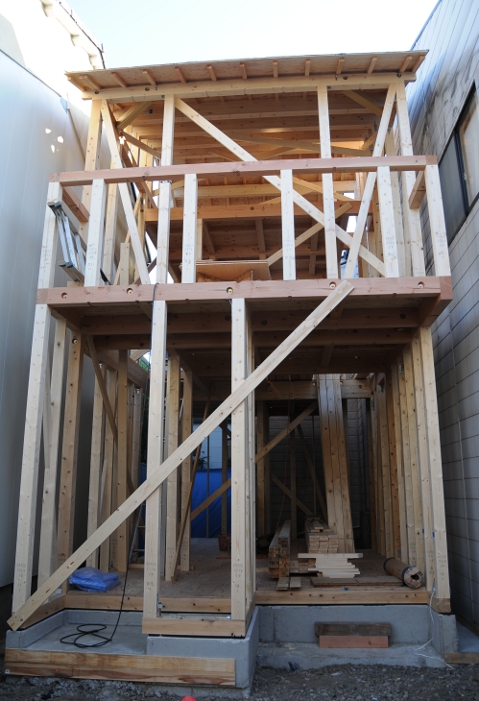 Take a closer look, do you notice the numbers on the timber? Every wooden beam has its individual number, obviously the construction plan contains the same numbers. Thus, the whole house can be prefabricated somewhere off site, and only needs to be assembled with the right pieces in the right place and order. No wonder they can be so fast in building a house in Japan!
Take a closer look, do you notice the numbers on the timber? Every wooden beam has its individual number, obviously the construction plan contains the same numbers. Thus, the whole house can be prefabricated somewhere off site, and only needs to be assembled with the right pieces in the right place and order. No wonder they can be so fast in building a house in Japan!  To be quite honest though, the whole thing appears to me rather flimsy. Clearly, the house will gain further strength by adding the walls, so maybe proper joining is not really necessary. Still, I have the impression a really big earthquake and these things are flattened in a heartbeat. Not like that 500-year-old farmer’s house I have seen that survived a very strong earthquake practically intact – albeit 1 metre off its original location…
To be quite honest though, the whole thing appears to me rather flimsy. Clearly, the house will gain further strength by adding the walls, so maybe proper joining is not really necessary. Still, I have the impression a really big earthquake and these things are flattened in a heartbeat. Not like that 500-year-old farmer’s house I have seen that survived a very strong earthquake practically intact – albeit 1 metre off its original location…
Proficiency
I have stumbled across a brand new study that examined the average English proficiency of adults in more than 60 countries that are not English native speaking (obviously).
There are five levels, ranging from very high – high – moderate – low – to very low proficiency. As was to be expected, Europe takes the cake, the seven countries that have very high proficiency in English are all European ones, starting with Denmark, The Netherlands and the other Scandinavian states on top, followed by a quite surprising Poland – and, on the seventh spot: Austria! 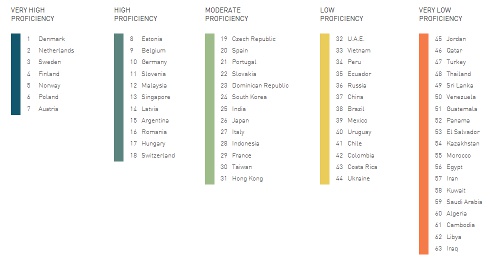
This surprised me quite a lot to be honest, I always had the impression that the average Austrian’s English-speaking capability was not that good at all. Although, I have to admit that several people who have travelled to Austria – even to the more rural spots – have assured me they got by fine without knowing any German. Maybe things have changed since I left?
Similarly surprising was the ranking of Japan on place 26 with moderate proficiency. I also thought that this was a bit overenthusiastic, but I have to admit that many Japanese understand English very well, and their grammar is excellent – they just don’t speak English. Interestingly the study states that not much had changed in Japan in the last seven years, when the first such study was conducted.
Of course, these kind of studies always have to be taken with a grain of salt. With this one, you need lots of grains: Nowhere on the site that I linked to above does it say how “proficiency” is measured, and what it takes to have a very high or very low one. Also they said they only tested adults (over 19 years of age) who had internet access (which accounts for a complete lack of central and south African countries) and who were somehow interested in learning (more) English already.
Anyway, it’s fun to check out this page (click on the spotlights to see each country’s individual score) and there is even a way to participate in the test – which takes only 50 minutes… Maybe the right thing to do on a slow weekend?
Yesterday, I got mail! Well, actually – as our doorbell does not work – there was a notice in the letterbox that I had received a registered letter in my absence. I could not really make out the sender – too many Kanji in a row – but it started with “Kyoto City…”
I have been a foreign resident in many countries and receiving unsolicited mail from any government related source (especially if registered) very quickly produces a very specific thing: A knot in my stomach. The first thing I did was checking my visa: No, expiration date is still some time in May next year, so this was unlikely to be the issue. I relaxed a little and took some time to look up all the Kanji and the sender appeared to be my health insurance. Okay okay, yes, I was indeed 4 days late with my last payment, but there is really no need to get that personal and registered within less than a week…
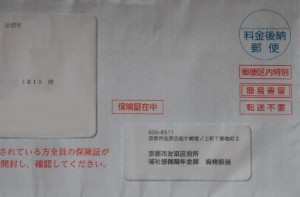 When I finally picked up the letter from the post office in the evening, all my stomach troubles turned out to have been for nothing: I simply received – like all the other Japanese – a new health insurance card. It seems that you are issued a new card every year by the end of November. The new one is green-ish, but besides the colour nothing has changed.
When I finally picked up the letter from the post office in the evening, all my stomach troubles turned out to have been for nothing: I simply received – like all the other Japanese – a new health insurance card. It seems that you are issued a new card every year by the end of November. The new one is green-ish, but besides the colour nothing has changed.
On the back of the card there is a little form on which you can indicate whether you’d like to be an organ donor, and under which circumstances. The default state is NO, but you can also agree to your organs being harvested in case of cardiac arrest or in case of brain death + cardiac arrest. I like this idea of doing it; it is very straightforward and easy to do, and the nicest thing about it is that you can change your mind every year. Apparently, not many Japanese allow their organs to be taken, which is a pity. I don’t care what happens to any leftovers once I’m dead, so I said YES.
Life and Death
Today was a lovely sunny day, so I decided around noon to go out. I wanted to take a little hike up to Mount Daimonji, behind Ginkakuji, but I misinterpreted a sign, took a wrong turn and ended up in a cemetery. I like graveyards, so I walked through the rows a little, and it certainly proved worth it.
It was a most interesting cemetery indeed – in front were the normal tombs I have seen so often before on Buddhist graveyards. Many of the tombs were modern, but here and there were old ones, huges stones with inscriptions and here and there a stone torii in front of them.
Further towards the back, however, there were tombs of a different kind: Still in massive stone, one could find ones with inscriptions in Hiragana, Latin, and even in English; with names engraved in Katakana. There was even one with an inscription in Portuguese. On one tomb it said “Do not stand on my grave and weep. I am not here, I do not sleep. I am the thousand winds.” Never before in Japan had I stood on a Christian graveyard. It felt odd somehow. 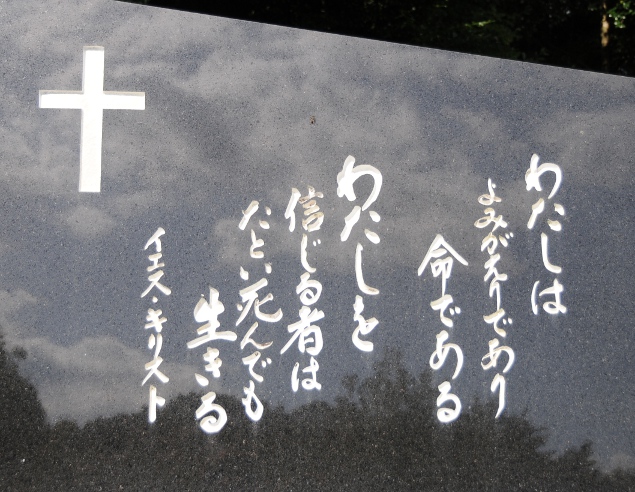 The inscription above is a translation of John 11:25, by the way.
The inscription above is a translation of John 11:25, by the way.
Guests
My landlady had guests last week – and because she lives in a very small Japanese house, she had them stay overnight with us in, well, the guesthouse. They left in the early afternoon today for Osaka.
Not three hours later we noticed that our toilets were blocked, both of them… Thank goodness my landlady was around and with the help of our usual builder – who came after 6 pm, on a Friday night! – and a lot of running water, we have now at least one fully functioning toilet again.Things like this do happen on occasion of course, but you can imagine my landlady was not entirely pleased.
There were a few other things that made that visit not too pleasant for her, but I am not going to share them here. I can share one of my own experiences with those guests though: When I came down to the bathroom on Monday morning, I noticed – even in that almost brainless state I occupy the first two hours after getting up – that some of my toiletries were gone: shampoo and soap were missing, and somebody had obviously used my hairbrush and face cream. I was glad one of the new guests was there, so I complained; I mean, who else could have done this?
It turned out that her husband had appropriated my stuff because he thought that those were things left behind by former tenants. I’m sorry – what? You come into a shared house, where you know several people are living right now, and the first thing you assume when you enter the bathroom is that the stuff on the shelf is abandoned? I have to give it to him: He was the first one in all my 18 months of living here to have had that glorious idea…
At least they didn’t take much, and when I complained I got everything back. Also, when I checked my kitchen shelf just before, I found two newly abandoned bananas, and we have a large stash of toilet paper. In case of any more geniuses moving in in the future, I have now labelled my basket of toiletries with my name though.
Poetry Game
Last Monday, suitable for the Culture Day, there was a traditional event that goes back about 1000 years, centred on one of Japan’s favourite pastimes taking place in Jonangu shrine which is equally old and lies in southern Kyoto. The event is called kyokusui-no-en and it is a kind of poetry game or competition involving multiple poets, a little stream, and enormous amounts of sake.
The idea is as follows: A number of poets sit on the banks of a little stream that flows through Jonangu shrine. They all have to compose a tanka – a poem of exactly 31 syllables – on a predefined topic, in a predefined amount of time. How long they have is determined by the stream and the sake: Little sake cups are released upstream and when they reach the last person, the poets must be finished, and then all the poems are read aloud.
I arrived at the shrine – after a trip of 90 minutes, and I hadn’t even left Kyoto just yet – about one hour before the event started. The shrine is very large and has two beautiful gardens with stones and trees and big koi ponds and streams in between. It seems that the cherry blossoms are famous there, but even now the gardens are a beautiful sight. When I arrived at the appropriate part of the garden, I was surprised to see that benches had been set up for the spectators, not just for the honorable paying guests, but for all of us. Never before did that happen, maybe the event was just the right size for this to be feasible.
Another nice surprise were five ladies giving a little koto concert before the main event started. Usually, the spectators are expected to wait in silence until the start of the main performance, but I think everybody was pleasantly surprised. The koto is a traditional Japanese instrument, but they played comparatively modern songs – they had a melody…
The main event – I’m still undecided whether to call it a ceremony, a game, a competition… – started at one o’clock with all the participants, all dressed beautifully in elaborate Heian-style costumes, entering the garden from the main shrine building: First a few attendants from the shrine, then traditional musicians and a dancer, then the seven poets who would take part in the game, and two children who carried long bamboo sticks and were charged with an important role during the game. I’ll get to that in a moment. 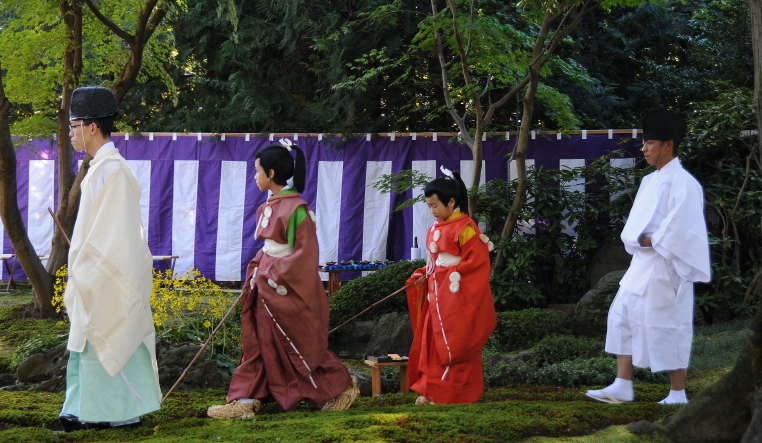 First, there was some traditional Heian-era court music, thankfully short, and a dancer gave a performance, with traditionally prescribed movements, all executed very precisely, and certainly with a lot of meaning behind each gesture, decipherable only for the initiated.
First, there was some traditional Heian-era court music, thankfully short, and a dancer gave a performance, with traditionally prescribed movements, all executed very precisely, and certainly with a lot of meaning behind each gesture, decipherable only for the initiated. 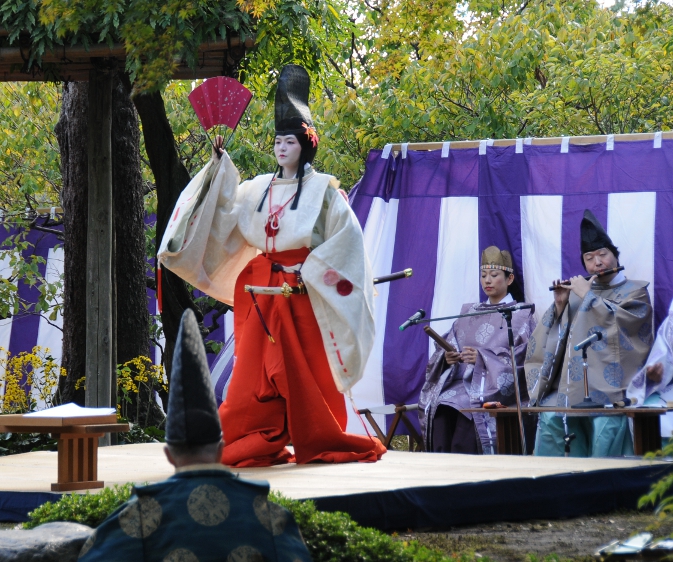
Then, the seven poets were shown a scroll – I assume that the topic of the poem they had to compose was written on it – and then they took their places along the little stream. 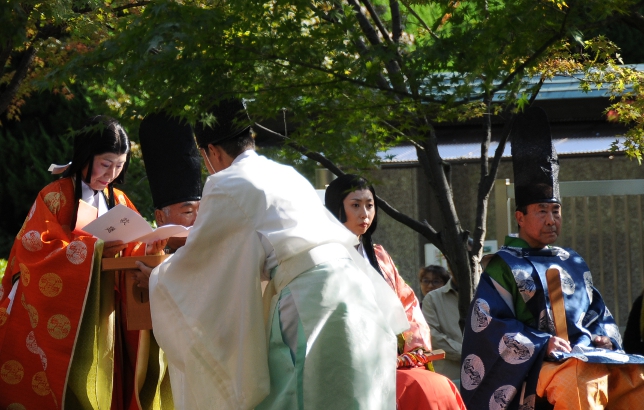
On each place there had been prepared a little cushion and a tiny table with writing utensils: ink, brush, and paper. When they were settled and ready to write, the first cup of sake was released upstream. 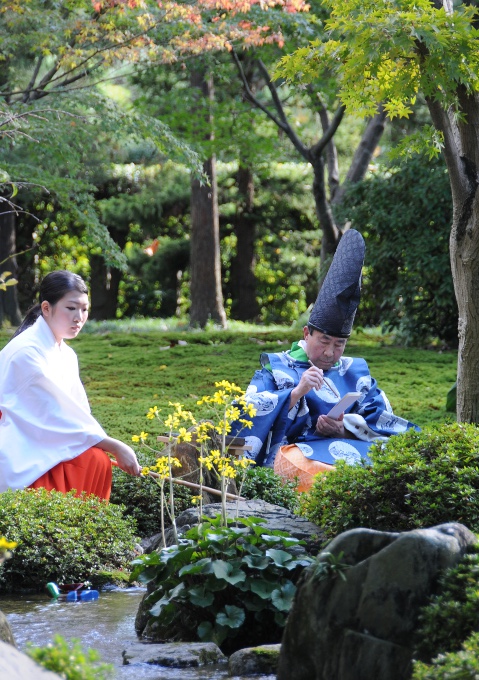
The cups were mounted on little duck-shaped boats and, as the stream was rather rapidly flowing, they picked up quite some speed. Probably because of that, there was not a single sake-duck released, but quite a number of them, although I could not count them from my vantage point. I did notice, however, that, although the stream was comparatively broad, that sometimes the little ducks would get stuck, and this is where the two children came in. With their long bamboo poles they were supposed to help the sake on its way, and they did so by wandering around the stream and the poets with earnest faces and a grave manner.
When the last sake duck had reached the last poet, all poems were collected. A group of five men dressed like priests would sit down on the platform where the dancer had given her performance before, and then would read each poem. First, the name of the writer was announced (and probably also the poetry school he came from, but I am guessing here) and then the poem was read once by one person, and then by all of them, both times in a kind of chant, as I have seen before at religious ceremonies. Obviously the topic had been somehow related to autumn, I could make out words like trees, colours, leaves, autumn, momiji…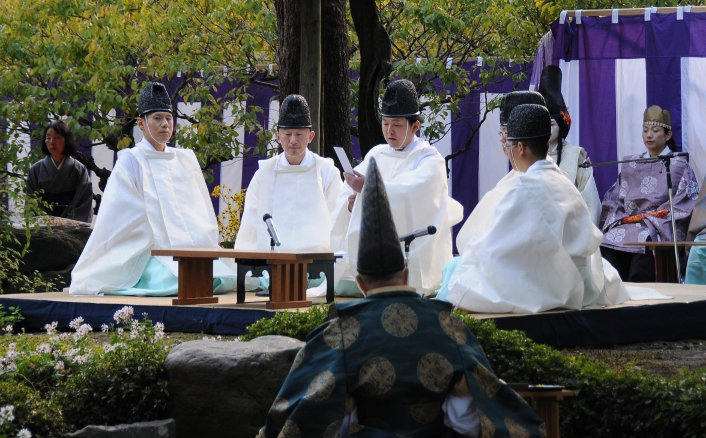 During the reading, more sake was sent down the stream, and this time I could see some of the poets drinking a cup or two. Howver, most of the sake was probably imbibed by the koi in the next pond… Anyway, after all the poems were read, the poets, dancers, and musicians left the garden. I thought there would be an announcement of a winner, a best poem nominated, but I was told that was not the purpose of the meeting. I know, however, that in the Genji Monogatari (*), where this game was already mentioned, there was always talk about people writing good and bad poems, so I think that in the olden days, there was probably lots of judgement going on…
During the reading, more sake was sent down the stream, and this time I could see some of the poets drinking a cup or two. Howver, most of the sake was probably imbibed by the koi in the next pond… Anyway, after all the poems were read, the poets, dancers, and musicians left the garden. I thought there would be an announcement of a winner, a best poem nominated, but I was told that was not the purpose of the meeting. I know, however, that in the Genji Monogatari (*), where this game was already mentioned, there was always talk about people writing good and bad poems, so I think that in the olden days, there was probably lots of judgement going on… 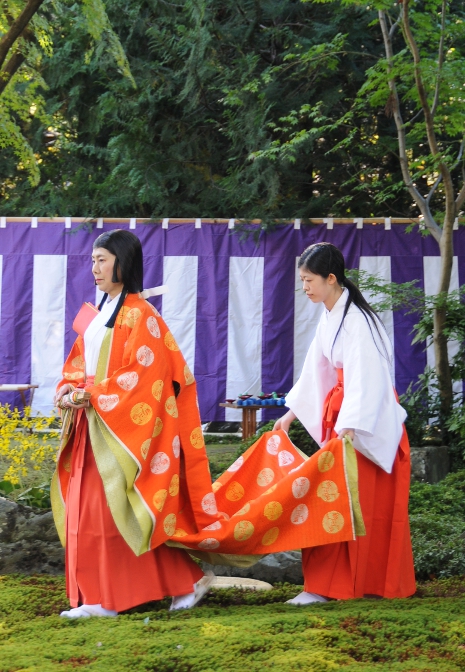 After the poets had left, there was a purification ceremony at the same little stream. People were invited to buy a little piece of paper in the shape of a man or woman, handle it in a prescribed way and then release it into the stream, to the incantations of a priest. Again, the two children were there and gently used their bamboo sticks to guide the prayers and wishes on their way.
After the poets had left, there was a purification ceremony at the same little stream. People were invited to buy a little piece of paper in the shape of a man or woman, handle it in a prescribed way and then release it into the stream, to the incantations of a priest. Again, the two children were there and gently used their bamboo sticks to guide the prayers and wishes on their way.
(*) The Genji Monogatari, the Tale of Genji, is one of the oldest Japanese novels, written in the 11th century by a lady in waiting on the Heian court. Apparently, the game had already taken place then in the same shrine as now.
